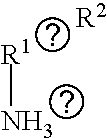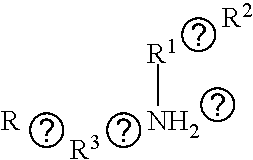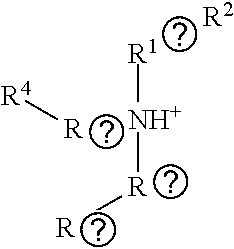Chemical Admixtures for Hydraulic Cements
a technology of hydraulic cement and chemical admixtures, which is applied in the direction of climate sustainability, solid waste management, sustainable waste treatment, etc., can solve the problems of large ecological footprint of opc manufacturing, high cost, and high cost of fly ash, so as to improve the properties of blended cement, improve the rate of hardness and compressive strength development, and improve the economics.
- Summary
- Abstract
- Description
- Claims
- Application Information
AI Technical Summary
Benefits of technology
Problems solved by technology
Method used
Image
Examples
example 1
Admixture C1. Sodium Glycolate: Na1(Gly)1
[0129]Sodium hydroxide (2.78 g) was dissolved with stirring (340 rpm) in water (9.6 g) maintained at 293 K, glycolic acid (7.57 g) added over 1 minute, and stirring continued at 293 K for 22 hours. A clear solution was obtained, and this was diluted to 6% w / w solids for testing.
example 2
Admixture C2. Aluminum(III) Glycolate: Al1(Gly)3
[0130]Aluminum(III) hydroxide (2.51 g) was suspended with stirring (340 rpm) in water (8.9 g) maintained at 343 K, glycolic acid (8.60 g) added over 1 minute, and stirring continued at 343 K for 70 hours. A white suspension was obtained, and this was diluted to 6% w / w solids for testing.
example 3
Admixture C3. Sodium Glycolatoaluminate(III): Na1Al1(Gly)1
[0131]Sodium hydroxide (1.19 g) was dissolved with stirring (340 rpm) in water (9.9 g) maintained at 293 K, glycolic acid (3.23 g) added over 2 minutes, and stifling continued for 15 minutes. Aluminum(III) hydroxide (5.65 g) was then added, the temperature raised to 343 K, and stifling continued for 70 hours. A white suspension was obtained, and this was diluted to 6% w / w solids for testing.
[0132]Admixtures C4-C11 were similarly prepared using the method of Example 3.
TABLE 9Preparation and Properties of Admixtures C1-C11AdmixturesReactants (Mass in g)Reaction Product#Mol CompositionNaOHAl(OH)3GlyWaterpHAppearanceC1Na1(Gly)12.78—7.579.611.8Clear SolutionC2Al1(Gly)3—2.518.608.93.2White SuspensionC3Na1Al1(Gly)11.195.653.239.98.8White SuspensionC4Na2Al2(Gly)31.393.315.689.68.1White SuspensionC5Na3Al2(Gly)31.923.055.239.810.7White SuspensionC6Na1Al1(Gly)21.202.846.509.58.5White SuspensionC7Na3Al2(Gly)41.672.656.059.611.1White Sus...
PUM
| Property | Measurement | Unit |
|---|---|---|
| w/w | aaaaa | aaaaa |
| shrinkage | aaaaa | aaaaa |
| hardness | aaaaa | aaaaa |
Abstract
Description
Claims
Application Information
 Login to View More
Login to View More - R&D
- Intellectual Property
- Life Sciences
- Materials
- Tech Scout
- Unparalleled Data Quality
- Higher Quality Content
- 60% Fewer Hallucinations
Browse by: Latest US Patents, China's latest patents, Technical Efficacy Thesaurus, Application Domain, Technology Topic, Popular Technical Reports.
© 2025 PatSnap. All rights reserved.Legal|Privacy policy|Modern Slavery Act Transparency Statement|Sitemap|About US| Contact US: help@patsnap.com



